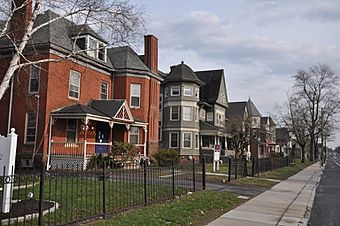Parkside Historic District (Hartford, Connecticut) facts for kids
Quick facts for kids |
|
|
Parkside Historic District
|
|
 |
|
| Location | 176-230 Wethersfield Ave. (even numbers), Hartford, Connecticut |
|---|---|
| Area | 2.6 acres (1.1 ha) |
| Built | 1885 |
| Architectural style | Colonial Revival, Queen Anne |
| NRHP reference No. | 84001048 |
| Added to NRHP | May 31, 1984 |
The Parkside Historic District is a special area in southern Hartford, Connecticut. It has a wonderful collection of old houses built in the Queen Anne style. These houses line the east side of Wethersfield Avenue.
This area was developed in the 1880s and 1890s. It was once part of a huge estate owned by Mrs. Elizabeth Jarvis Colt. She was the wife of Samuel Colt, who made famous firearms. Today, nine of these original houses are still standing. This historic district was added to the National Register of Historic Places in 1984.
A Look at the Parkside Historic District
Samuel Colt built his famous arms factory in Hartford. He also owned a very large personal estate nearby. Most of this land later became Hartford's Colt Park. His big mansion, Armsmear, is a National Historic Landmark. It is also part of the new Coltsville National Historical Park.
South of Armsmear, along Wethersfield Avenue, there was an apple orchard. In 1856, Samuel Colt built a home for his brother James in this area. Later, in the 1880s, Samuel's widow, Elizabeth, started building houses and selling land here. She had four houses built, and two of them are still here today. She also sold eight lots, and houses were built on all of them. Seven of those houses are still standing.
What Makes These Houses Special?
The nine houses that remain in the Parkside Historic District are great examples of the Queen Anne style. This was a very popular way to build houses back then. They all look similar in some ways. They are set back from the street by the same amount. They also have similar sizes and shapes.
All these houses are about two and a half stories tall. They are built on strong brownstone foundations. Six of the houses have brick on the outside. The other three are made of wood. These wooden houses have clapboards and shingles.
Queen Anne Style Details
The Queen Anne style is known for its unique look. These houses have parts that stick out, like gables and bays. Gables are the triangular parts of a wall under a sloping roof. Bays are window areas that project outward from the main walls. These features give the houses an interesting, uneven shape.
One house that stands out is at 190 Wethersfield Avenue. It was built around 1900 by William Scoville. He was a builder. This house has an eight-sided tower on one corner. William Scoville built this house and two others in the row. Other people who designed these houses include Frederick Comstock and Brooks Lincoln.



